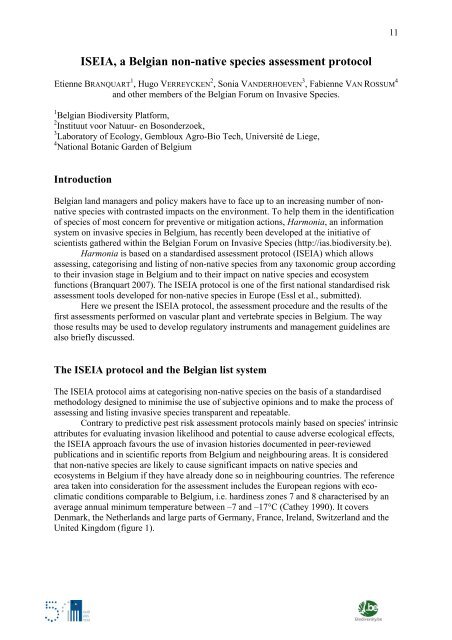Science Facing Aliens - Invasive Alien Species in Belgium - Belgian ...
Science Facing Aliens - Invasive Alien Species in Belgium - Belgian ...
Science Facing Aliens - Invasive Alien Species in Belgium - Belgian ...
You also want an ePaper? Increase the reach of your titles
YUMPU automatically turns print PDFs into web optimized ePapers that Google loves.
ISEIA, a <strong>Belgian</strong> non-native species assessment protocol<br />
Etienne BRANQUART 1 , Hugo VERREYCKEN 2 , Sonia VANDERHOEVEN 3 , Fabienne VAN ROSSUM 4<br />
and other members of the <strong>Belgian</strong> Forum on <strong>Invasive</strong> <strong>Species</strong>.<br />
1 <strong>Belgian</strong> Biodiversity Platform,<br />
2 Instituut voor Natuur- en Bosonderzoek,<br />
3 Laboratory of Ecology, Gembloux Agro-Bio Tech, Université de Liege,<br />
4 National Botanic Garden of <strong>Belgium</strong><br />
Introduction<br />
<strong>Belgian</strong> land managers and policy makers have to face up to an <strong>in</strong>creas<strong>in</strong>g number of nonnative<br />
species with contrasted impacts on the environment. To help them <strong>in</strong> the identification<br />
of species of most concern for preventive or mitigation actions, Harmonia, an <strong>in</strong>formation<br />
system on <strong>in</strong>vasive species <strong>in</strong> <strong>Belgium</strong>, has recently been developed at the <strong>in</strong>itiative of<br />
scientists gathered with<strong>in</strong> the <strong>Belgian</strong> Forum on <strong>Invasive</strong> <strong>Species</strong> (http://ias.biodiversity.be).<br />
Harmonia is based on a standardised assessment protocol (ISEIA) which allows<br />
assess<strong>in</strong>g, categoris<strong>in</strong>g and list<strong>in</strong>g of non-native species from any taxonomic group accord<strong>in</strong>g<br />
to their <strong>in</strong>vasion stage <strong>in</strong> <strong>Belgium</strong> and to their impact on native species and ecosystem<br />
functions (Branquart 2007). The ISEIA protocol is one of the first national standardised risk<br />
assessment tools developed for non-native species <strong>in</strong> Europe (Essl et al., submitted).<br />
Here we present the ISEIA protocol, the assessment procedure and the results of the<br />
first assessments performed on vascular plant and vertebrate species <strong>in</strong> <strong>Belgium</strong>. The way<br />
those results may be used to develop regulatory <strong>in</strong>struments and management guidel<strong>in</strong>es are<br />
also briefly discussed.<br />
The ISEIA protocol and the <strong>Belgian</strong> list system<br />
The ISEIA protocol aims at categoris<strong>in</strong>g non-native species on the basis of a standardised<br />
methodology designed to m<strong>in</strong>imise the use of subjective op<strong>in</strong>ions and to make the process of<br />
assess<strong>in</strong>g and list<strong>in</strong>g <strong>in</strong>vasive species transparent and repeatable.<br />
Contrary to predictive pest risk assessment protocols ma<strong>in</strong>ly based on species' <strong>in</strong>tr<strong>in</strong>sic<br />
attributes for evaluat<strong>in</strong>g <strong>in</strong>vasion likelihood and potential to cause adverse ecological effects,<br />
the ISEIA approach favours the use of <strong>in</strong>vasion histories documented <strong>in</strong> peer-reviewed<br />
publications and <strong>in</strong> scientific reports from <strong>Belgium</strong> and neighbour<strong>in</strong>g areas. It is considered<br />
that non-native species are likely to cause significant impacts on native species and<br />
ecosystems <strong>in</strong> <strong>Belgium</strong> if they have already done so <strong>in</strong> neighbour<strong>in</strong>g countries. The reference<br />
area taken <strong>in</strong>to consideration for the assessment <strong>in</strong>cludes the European regions with ecoclimatic<br />
conditions comparable to <strong>Belgium</strong>, i.e. hard<strong>in</strong>ess zones 7 and 8 characterised by an<br />
average annual m<strong>in</strong>imum temperature between –7 and –17°C (Cathey 1990). It covers<br />
Denmark, the Netherlands and large parts of Germany, France, Ireland, Switzerland and the<br />
United K<strong>in</strong>gdom (figure 1).<br />
11


